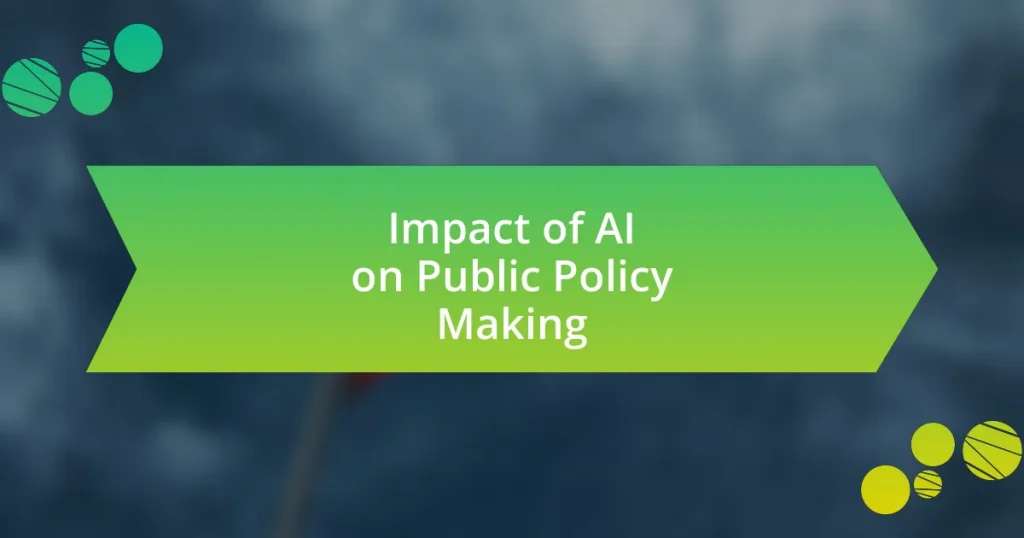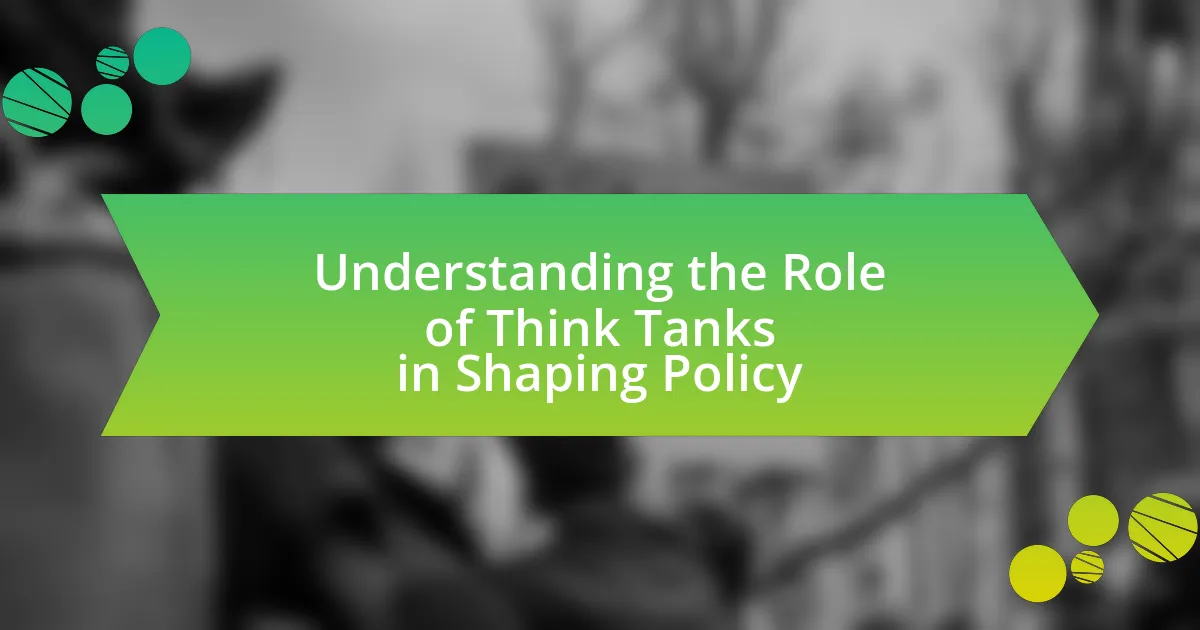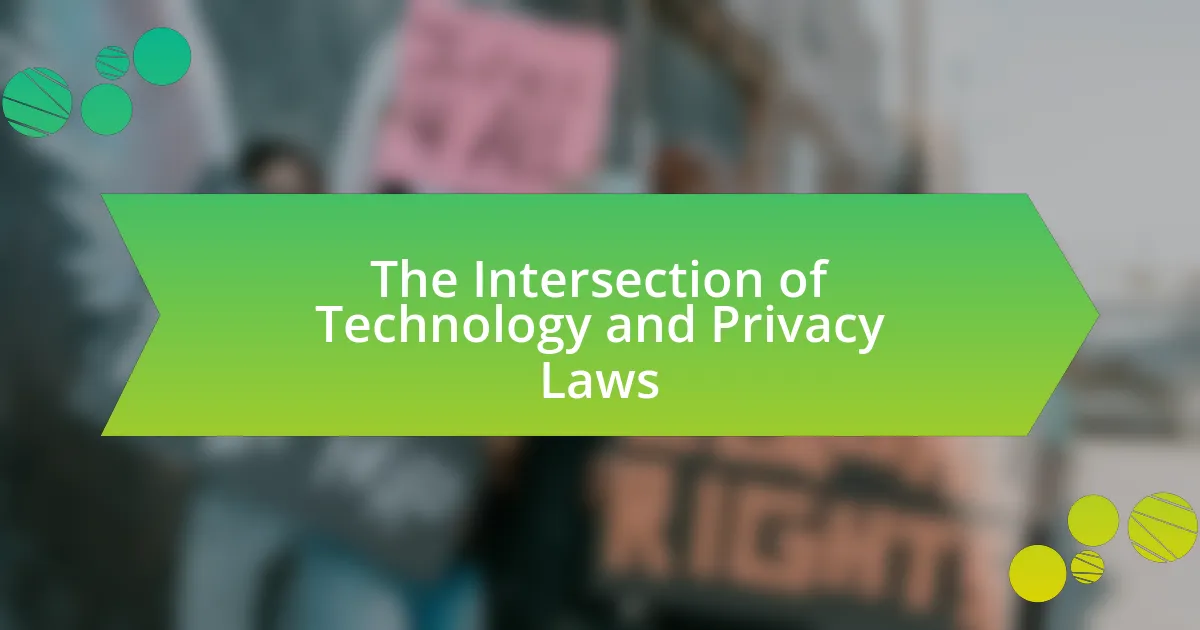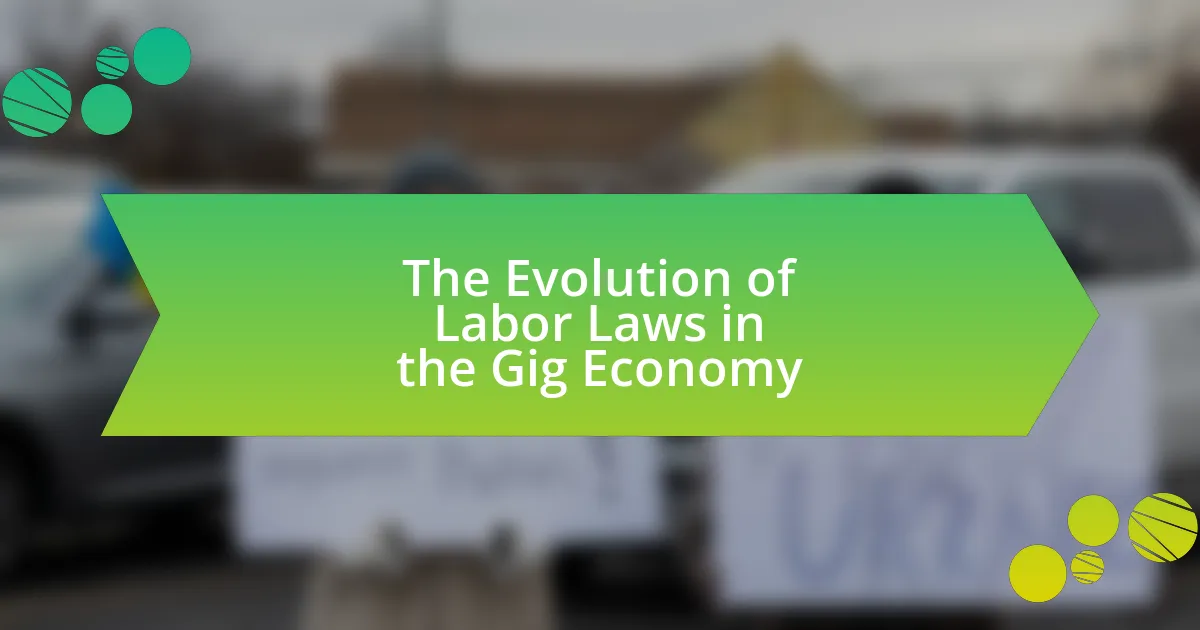The article examines the significant impact of artificial intelligence (AI) on public policy making, highlighting its role in enhancing data analysis, improving decision-making processes, and fostering responsive governance. It discusses current applications of AI in policy formulation, including data analytics, predictive modeling, and stakeholder engagement, while identifying key technologies such as machine learning and natural language processing. The article also addresses the potential benefits of AI integration, including increased efficiency and transparency, as well as challenges related to data privacy, algorithmic bias, and ethical considerations. Furthermore, it explores future trends in AI and public policy, emphasizing the need for ethical frameworks and collaboration between tech experts and policymakers to ensure responsible AI use.
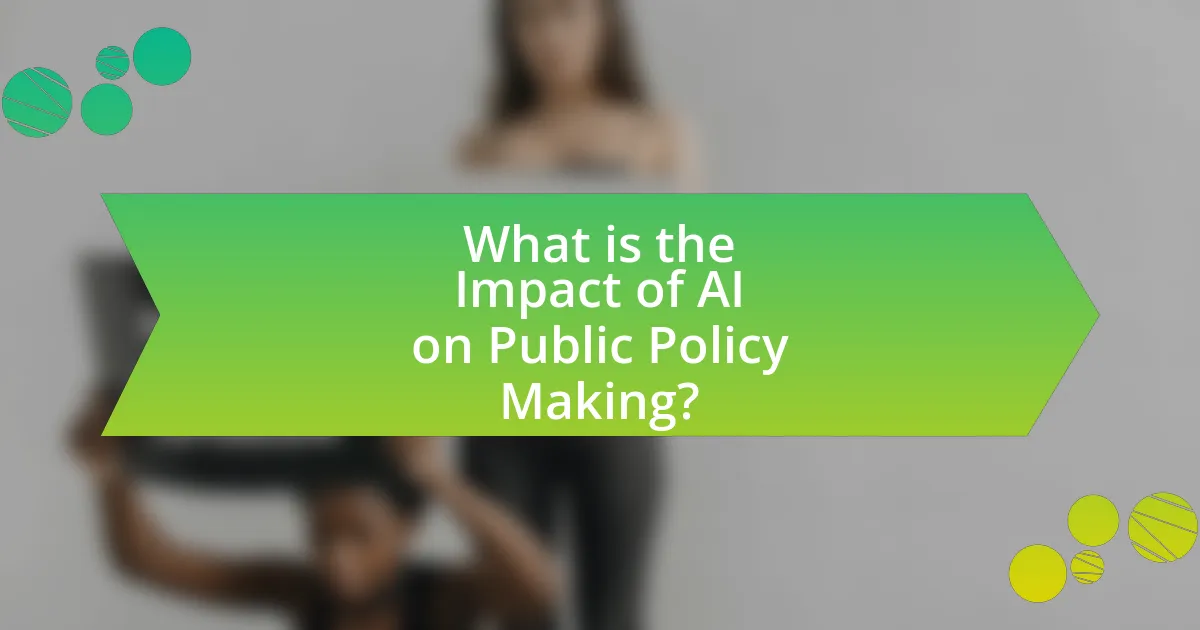
What is the Impact of AI on Public Policy Making?
The impact of AI on public policy making is significant, as it enhances data analysis, improves decision-making processes, and fosters more responsive governance. AI technologies enable policymakers to analyze vast amounts of data quickly, leading to more informed decisions based on evidence rather than intuition. For instance, AI can identify trends in public health data, allowing for timely interventions during crises, such as the COVID-19 pandemic, where AI-driven models helped predict outbreaks and allocate resources effectively. Additionally, AI tools facilitate citizen engagement by analyzing public sentiment and feedback, which can guide policy adjustments. The integration of AI in public policy has been shown to increase efficiency and transparency, ultimately leading to better outcomes for society.
How is AI currently being utilized in public policy making?
AI is currently utilized in public policy making through data analysis, predictive modeling, and stakeholder engagement. Governments and organizations employ AI algorithms to analyze large datasets, which helps identify trends and inform policy decisions. For instance, AI tools can predict the impact of proposed regulations by simulating various scenarios based on historical data. Additionally, AI facilitates stakeholder engagement by analyzing public sentiment through social media and surveys, allowing policymakers to gauge community responses to potential policies. This application of AI enhances the efficiency and effectiveness of policy formulation, as evidenced by initiatives like the European Commission’s use of AI in assessing the impact of legislation.
What are the key technologies driving AI in public policy?
Key technologies driving AI in public policy include machine learning, natural language processing, and data analytics. Machine learning algorithms analyze large datasets to identify patterns and predict outcomes, enabling policymakers to make informed decisions. Natural language processing facilitates the understanding of public sentiment and feedback through social media and other communication channels, allowing for more responsive governance. Data analytics provides insights into demographic trends and resource allocation, enhancing the efficiency of public services. These technologies collectively empower governments to improve policy formulation and implementation, as evidenced by their increasing adoption in various governmental agencies worldwide.
How do these technologies influence decision-making processes?
Technologies such as artificial intelligence significantly influence decision-making processes by enhancing data analysis, improving predictive capabilities, and facilitating real-time insights. AI algorithms can process vast amounts of data quickly, allowing policymakers to identify trends and patterns that inform their decisions. For instance, a study by the McKinsey Global Institute found that organizations using AI for decision-making can improve their productivity by up to 40%. This capability enables more informed and timely decisions, ultimately leading to better public policy outcomes.
What are the potential benefits of integrating AI into public policy?
Integrating AI into public policy can enhance decision-making efficiency and improve service delivery. AI systems can analyze vast amounts of data quickly, enabling policymakers to identify trends, predict outcomes, and allocate resources more effectively. For instance, a study by the McKinsey Global Institute found that AI could potentially increase productivity by up to 40% in various sectors, including public administration. Additionally, AI can facilitate personalized services for citizens, leading to higher satisfaction rates. By automating routine tasks, AI allows public servants to focus on more complex issues, ultimately improving governance and responsiveness.
How can AI improve efficiency in policy formulation?
AI can improve efficiency in policy formulation by analyzing vast amounts of data to identify trends and inform decision-making. By utilizing machine learning algorithms, AI can process complex datasets, such as public opinion surveys and economic indicators, to provide insights that human analysts may overlook. For instance, a study by the McKinsey Global Institute found that AI can reduce the time spent on data analysis by up to 70%, allowing policymakers to focus on strategic planning and implementation. This capability enhances the speed and accuracy of policy development, ultimately leading to more effective governance.
What role does AI play in enhancing data analysis for policy decisions?
AI significantly enhances data analysis for policy decisions by enabling more accurate predictions and insights through advanced algorithms and machine learning techniques. These technologies process vast amounts of data quickly, identifying patterns and trends that human analysts may overlook. For instance, AI can analyze social media sentiment to gauge public opinion on policy issues, providing real-time feedback that informs decision-making. Additionally, AI-driven models can simulate the potential impacts of various policy options, allowing policymakers to evaluate outcomes before implementation. This capability is supported by studies showing that AI applications in public policy can improve efficiency and effectiveness, as evidenced by the use of predictive analytics in urban planning and resource allocation.
What challenges does AI present in public policy making?
AI presents several challenges in public policy making, primarily related to data privacy, algorithmic bias, and transparency. Data privacy concerns arise as AI systems often require vast amounts of personal data, which can lead to violations of individual privacy rights. For instance, the General Data Protection Regulation (GDPR) in Europe highlights the need for strict data handling practices, emphasizing the importance of consent and data protection.
Algorithmic bias is another significant challenge, as AI systems can perpetuate or even exacerbate existing societal biases if not carefully monitored. Research from MIT Media Lab found that facial recognition systems had higher error rates for individuals with darker skin tones, illustrating the potential for discriminatory outcomes in policy applications.
Lastly, transparency in AI decision-making processes is crucial for accountability. Many AI models operate as “black boxes,” making it difficult for policymakers to understand how decisions are made. This lack of transparency can undermine public trust and hinder effective governance. The AI Now Institute emphasizes the need for explainable AI to ensure that policy decisions are based on clear and understandable criteria.
How does bias in AI algorithms affect policy outcomes?
Bias in AI algorithms can significantly skew policy outcomes by perpetuating existing inequalities and misrepresenting data. When AI systems are trained on biased datasets, they can produce recommendations that favor certain demographics over others, leading to policies that may disadvantage marginalized groups. For instance, a study by ProPublica found that an algorithm used in the criminal justice system was biased against African American defendants, resulting in harsher sentencing recommendations. This illustrates how biased AI can influence judicial policies, reinforcing systemic discrimination. Furthermore, biased AI can misinform policymakers by providing skewed insights, ultimately leading to ineffective or harmful public policies.
What ethical considerations arise from using AI in public policy?
The ethical considerations arising from using AI in public policy include issues of bias, transparency, accountability, and privacy. Bias in AI algorithms can lead to discriminatory outcomes, as seen in studies where predictive policing tools disproportionately target marginalized communities. Transparency is crucial, as stakeholders need to understand how AI systems make decisions; lack of clarity can erode public trust. Accountability is another concern, as it can be unclear who is responsible for decisions made by AI systems, complicating the attribution of blame in cases of failure or harm. Lastly, privacy issues emerge when AI systems collect and analyze vast amounts of personal data, raising concerns about surveillance and data security. These considerations highlight the need for ethical frameworks to guide the integration of AI in public policy.

How does AI influence stakeholder engagement in public policy?
AI significantly enhances stakeholder engagement in public policy by facilitating data-driven decision-making and improving communication channels. Through advanced analytics, AI enables policymakers to analyze vast amounts of data from diverse stakeholder groups, leading to more informed and inclusive policy development. For instance, AI tools can process public feedback from social media and surveys, allowing policymakers to gauge public sentiment and prioritize issues that matter most to constituents. This data-driven approach not only increases transparency but also fosters trust among stakeholders, as they see their input reflected in policy outcomes. Additionally, AI-powered platforms can streamline collaboration among stakeholders, ensuring that diverse voices are heard and considered in the policymaking process.
What methods are used to involve citizens in AI-driven policy processes?
Citizens are involved in AI-driven policy processes through methods such as participatory design, public consultations, and collaborative platforms. Participatory design engages citizens in the development of AI systems, ensuring their needs and perspectives are integrated. Public consultations allow citizens to provide feedback on proposed policies, fostering transparency and inclusivity. Collaborative platforms, such as online forums and workshops, facilitate dialogue between policymakers and citizens, enabling co-creation of solutions. These methods enhance democratic engagement and ensure that AI applications in policy reflect the values and priorities of the community.
How can AI tools facilitate public participation in policy making?
AI tools can facilitate public participation in policy making by enabling more efficient data collection and analysis, which enhances citizen engagement. For instance, platforms powered by AI can analyze public sentiment from social media and surveys, allowing policymakers to understand community needs and preferences more effectively. A study by the Pew Research Center found that 70% of Americans believe technology can improve government responsiveness, indicating a strong public interest in utilizing AI for participatory governance. Additionally, AI-driven chatbots can provide real-time information and answer citizen queries, further encouraging involvement in the policy-making process.
What are the implications of AI on transparency and accountability?
AI significantly impacts transparency and accountability by enhancing data accessibility and enabling automated decision-making processes. The integration of AI in public policy allows for real-time data analysis, which can improve the visibility of government actions and decisions. For instance, AI-driven platforms can aggregate and present data on public spending, making it easier for citizens to track how funds are allocated and spent. Furthermore, AI can help identify biases in decision-making, promoting accountability by ensuring that policies are based on objective data rather than subjective judgments. Studies, such as those conducted by the Brookings Institution, indicate that AI can facilitate greater public engagement by providing clearer insights into governmental processes, thereby fostering a more informed citizenry.
How do policymakers perceive the role of AI in their work?
Policymakers perceive AI as a transformative tool that enhances decision-making and efficiency in their work. They recognize that AI can analyze vast amounts of data quickly, providing insights that inform policy development and implementation. For instance, a report by the McKinsey Global Institute highlights that AI can improve public sector productivity by up to 20-30%, enabling policymakers to allocate resources more effectively and respond to citizen needs more promptly. This perception is further supported by case studies where AI applications in areas like traffic management and public health have led to improved outcomes, demonstrating its potential to drive innovation in public policy.
What concerns do policymakers have regarding AI implementation?
Policymakers have significant concerns regarding AI implementation, primarily focusing on ethical implications, job displacement, and data privacy. Ethical implications arise from the potential for biased algorithms that can perpetuate discrimination, as evidenced by studies showing that AI systems can reflect societal biases present in training data. Job displacement is another critical concern, with estimates suggesting that up to 800 million jobs could be affected by automation by 2030, according to a report by McKinsey Global Institute. Additionally, data privacy issues are paramount, as the collection and use of personal data by AI systems raise questions about consent and surveillance, highlighted by incidents like the Cambridge Analytica scandal. These concerns necessitate careful consideration and regulation to ensure responsible AI deployment.
How can policymakers be educated about AI’s capabilities and limitations?
Policymakers can be educated about AI’s capabilities and limitations through targeted training programs and workshops that focus on practical applications and ethical considerations. These educational initiatives should include collaboration with AI experts and practitioners who can provide real-world insights and case studies, enhancing understanding of both the potential benefits and risks associated with AI technologies. For instance, the Partnership on AI has developed resources aimed at informing policymakers about AI’s societal impacts, demonstrating the effectiveness of structured educational efforts in this area.
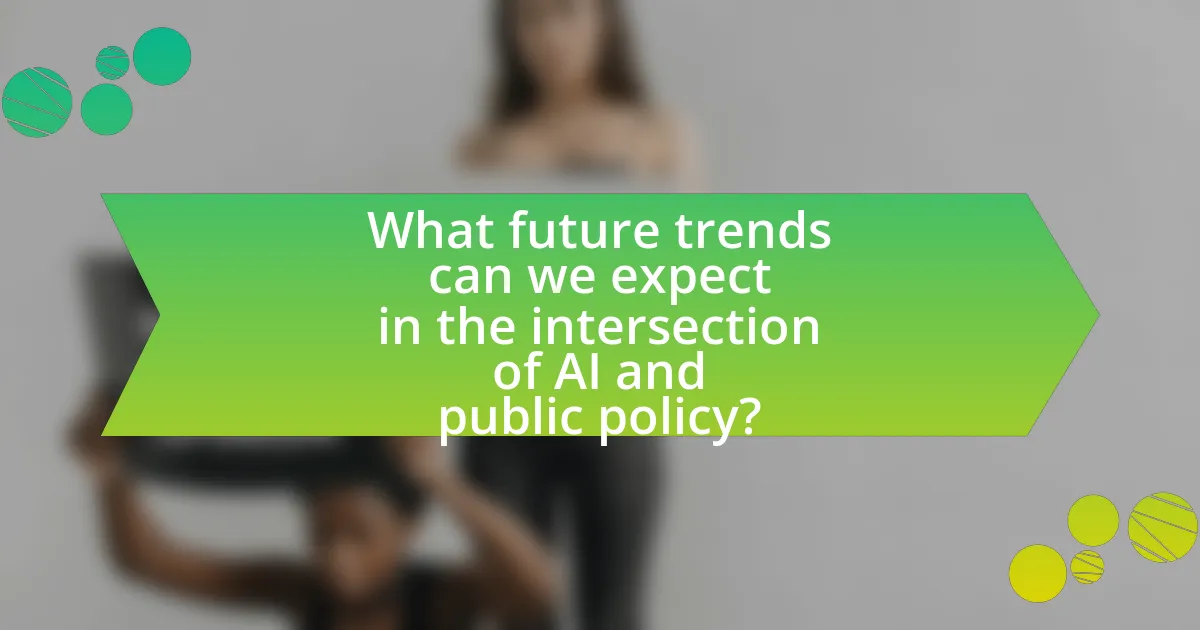
What future trends can we expect in the intersection of AI and public policy?
Future trends in the intersection of AI and public policy include increased reliance on data-driven decision-making, enhanced predictive analytics for policy outcomes, and the development of ethical frameworks for AI deployment. Governments are increasingly utilizing AI to analyze large datasets, which allows for more informed policy decisions that can adapt to changing societal needs. For instance, predictive analytics can help forecast the impact of policies on various demographics, leading to more equitable outcomes. Additionally, as AI technologies evolve, there is a growing emphasis on establishing ethical guidelines to ensure transparency, accountability, and fairness in AI applications within public policy. This trend is supported by initiatives from organizations like the OECD, which promotes responsible AI use in government.
How might AI shape the future of governance and public administration?
AI will significantly shape the future of governance and public administration by enhancing decision-making processes, improving service delivery, and increasing transparency. For instance, AI algorithms can analyze vast amounts of data to identify trends and inform policy decisions, leading to more effective governance. A study by the McKinsey Global Institute found that AI could potentially increase public sector productivity by up to 20%, enabling governments to allocate resources more efficiently. Additionally, AI-driven chatbots and virtual assistants can streamline citizen interactions with government services, making them more accessible and responsive. This integration of AI not only fosters a data-driven approach to public administration but also promotes accountability through improved monitoring and evaluation of government actions.
What emerging technologies could further influence public policy making?
Emerging technologies such as artificial intelligence, blockchain, and big data analytics could significantly influence public policy making. Artificial intelligence can enhance decision-making processes by providing data-driven insights and predictive analytics, enabling policymakers to anticipate societal needs and challenges. Blockchain technology offers transparency and security in public transactions, which can improve trust in government processes and reduce corruption. Big data analytics allows for the aggregation and analysis of vast amounts of information, helping policymakers understand trends and public sentiment more effectively. These technologies are already being integrated into various governmental functions, demonstrating their potential to reshape policy frameworks and improve governance.
How can governments prepare for the evolving role of AI in policy?
Governments can prepare for the evolving role of AI in policy by establishing regulatory frameworks that promote ethical AI use while ensuring transparency and accountability. This involves creating guidelines that govern AI deployment in public services, which can enhance decision-making efficiency and improve citizen engagement. For instance, the European Union’s proposed AI Act aims to regulate high-risk AI applications, ensuring they meet safety and ethical standards. Additionally, governments should invest in training public officials on AI technologies to foster informed policy-making. Research indicates that countries with robust AI strategies, like Canada, have seen improved public sector innovation and service delivery.
What best practices should be adopted for effective AI integration in public policy?
Effective AI integration in public policy requires transparency, stakeholder engagement, and continuous evaluation. Transparency ensures that AI algorithms and their decision-making processes are understandable to the public, fostering trust and accountability. Stakeholder engagement involves including diverse voices, such as community members and experts, in the development and implementation of AI systems, which enhances the relevance and effectiveness of policies. Continuous evaluation is crucial for assessing the impact of AI on policy outcomes, allowing for adjustments based on data-driven insights. For instance, the European Commission emphasizes these practices in its guidelines for trustworthy AI, highlighting the importance of ethical considerations and public involvement in AI governance.
How can collaboration between tech experts and policymakers be fostered?
Collaboration between tech experts and policymakers can be fostered through structured dialogue platforms that facilitate knowledge exchange. These platforms, such as workshops, roundtable discussions, and joint task forces, enable both parties to share insights on technological advancements and regulatory needs. For instance, the National Institute of Standards and Technology (NIST) has successfully engaged stakeholders in developing frameworks for AI governance, demonstrating the effectiveness of collaborative efforts in shaping public policy. By establishing regular communication channels and collaborative projects, both tech experts and policymakers can align their objectives and enhance the impact of AI on public policy making.
What frameworks can ensure ethical AI use in public policy making?
The frameworks that can ensure ethical AI use in public policy making include the Ethical AI Framework, the AI Ethics Guidelines from the European Commission, and the OECD Principles on Artificial Intelligence. The Ethical AI Framework emphasizes transparency, accountability, and fairness in AI systems, which are crucial for public trust and effective governance. The European Commission’s AI Ethics Guidelines provide a comprehensive set of principles aimed at promoting trustworthy AI, including human oversight and societal well-being. The OECD Principles on Artificial Intelligence advocate for inclusive growth and sustainable development, ensuring that AI technologies benefit society as a whole. These frameworks collectively guide policymakers in integrating ethical considerations into AI deployment, thereby fostering responsible and equitable public policy.
